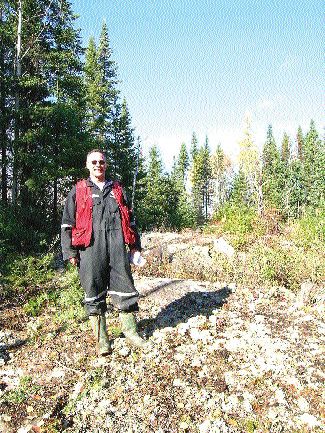Val d’Or, Que. —
During a swing through the area, The Northern Miner noted that drilling was under way on one project and planned for another. But when the slate of targets is this large (58 in the Abitibi alone), it’s routine for a company to spend a few weeks on one property, then move on to another.
Project generation begins with a study of historical geological maps and reports, and Golden Valley has many. If the geology looks interesting, prospecting is carried out, followed by geochemical and geophysical surveys. Geophysics is the tool of choice for locating targets prior to drilling.
Some targets are buried under farmers’ fields; others are accessible only by traversing those fields. In the 1920s and 1930s, a lot of discoveries were made as a result of finding and sampling outcrop. The Abitibi does not have much outcrop to begin with (more than 90% is covered by overburden), so most of the remaining targets — and there are a lot of them in this gold- and base metal-rich greenstone belt — are buried.
Golden Valley has found that it is more economical to drill 100-metre holes than to strip, trench and sample targets.
In 2004, the company generated 23 projects, 13 of which are in the Abitibi. Seventy-seven holes (10,000 metres) were drilled last year, of which 31 targeted gold, 30 aimed for nickel, copper and platinum group elements (in the Ungava region of northern Quebec), and 16 explored for copper-zinc.
On average, two properties are evaluated each month. Prospects are drilled, and if results are encouraging, a partner is sought (Golden Valley prefers to seek partners who will invest their own money to firm up resources). About $67,000 is budgeted for each property, which is sufficient for 2-3 drill holes.
At presstime, a drill was being set up on the Double Trouble prospect, 12 km east of Duparquet. Results from induced-polarization surveys suggest the presence of shear zones near the surface, and Golden Valley believes these could relate to past-producing gold-mineralized zones.
Drilling is also planned for the Winnie Lake copper-zinc occurrence, near Kirkland Lake, Ont. A hole sunk in 1989 returned 22.5 metres grading 2.6% copper and 2.3% zinc, plus 17 grams silver and 1 gram gold per tonne. However, mineralization was cut off by a syenite intrusion. Recently, Golden Valley used geophysics to generate three new targets, one of which may be an extension of the known orebody.
Grassroots exploration is a risky business, but Golden Valley has a strategy for managing that risk: “We reduce the risk by using geophysics, geochemistry and geological ideas to pick the best targets,” said President Glen Mullan.
Most of its projects are in the Abitibi, but Golden Valley has expanded into northern Quebec and even joined the uranium bandwagon in northern Saskatchewan.
The West Shoot Out project, in which
The drilling extended, by 150 metres, the Alpha zone, which is hosted by an ultramafic intrusive rock along its contact with volcanic rocks. (The zone was drilled in the late 1980s, but in the wrong direction.)
At the India showing, 3 km to the west, hole 10 intersected 10 metres grading 1.09% nickel, 0.4% copper, 0.05% cobalt, 0.03 gram gold, 0.08 gram platinum, and 0.83 gram palladium. The interval included a 6-metre section grading 1.47% nickel and 0.4% copper. Pyrrhotite and chalcopyrite are hosted by pyroxenite. More drilling is planned.
And at the East Shoot Out project, in which
Three properties were drilled in late 2004: Heva Minor, Rivire Heva and Vassan. At Heva Minor, Golden Valley intersected anomalous copper-zinc-silver mineralization in a skarn-type setting; narrow zones of sphalerite were cut in three of four holes. At Rivire Heva, drilling encountered weakly anomalous gold to the east and along strike of historical drilling. No significant gold was reported at the Vassan prospect.
Drilling on other properties in 2004 may not have resulted in instant success, but Golden Valley remains optimistic.
At the Mindoka prospect, exploration crews targeted massive sulphide at the contact between mafic and felsic rocks; the holes cut stringers of chalcopyrite. “I am confident there is a [volcanogenic massive sulphide] deposit on this horizon, and that we can entice someone to go in and do a deep electromagnetic survey,” said Senior Project Geologist Michael Rosetelli.
Golden Valley continues to stake properties, including several molybdenite occurrences in the Abitibi region and some uranium prospects in the Mistassini area.
At the end of 2004, the company had 28 million shares outstanding (37.6 million fully diluted). These recently traded in the range of 25-30.


Be the first to comment on "Golden Valley explores properties in NW Quebec"